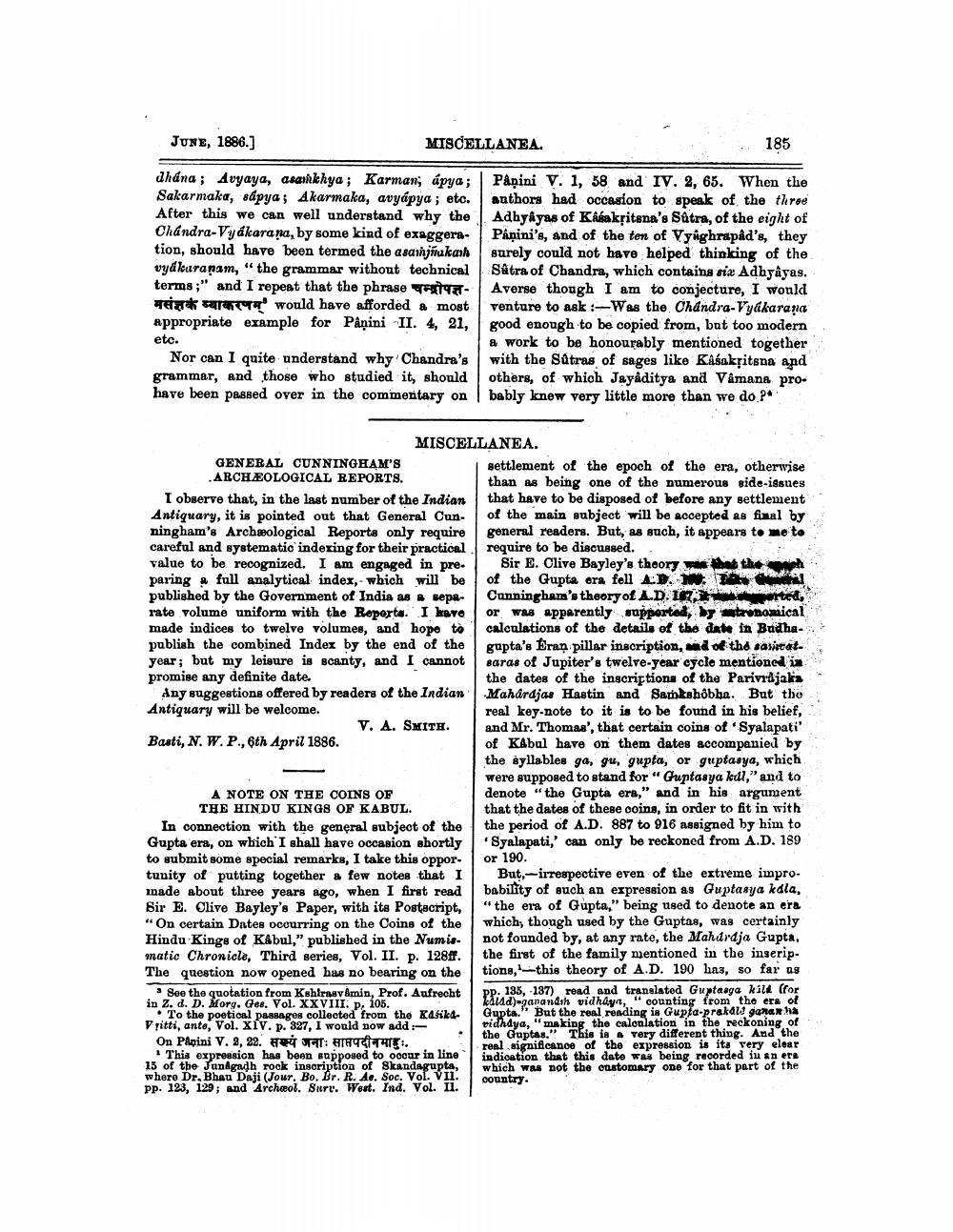________________
JUNE, 1886.)
MISCELLANEA.
185
dhdna ; Avyaya, asainkhya; Karman; ápya; Sakarmaka, sápya; Akarmaka, avyápya; etc. After this we can well understand why the Chandra-Vydkarana, by some kind of exaggera. tion, should have been termed the asajakah vydleuranam," the grammar without technical terms;" and I repeat that the phrase - H T T would have afforded a most appropriate example for Påņini II. 4, 21, etc.
Nor can I quite understand why Chandra's grammar, and those who studied it, should have been passed over in the commentary on
Paņini V. 1, 58 and IV. 2, 65. When the authors had occasion to speak of the three Adhyâyas of Kibakpitsna's Sætra, of the eight of Panini's, and of the ten of Vynghrapad's, they surely could not have helped thinking of the Satra of Chandra, which contains six Adhyâyas. Averse though I am to conjecture, I would venture to ask :-Was the Chandra-Vyakarana good enough to be copied from, but too modern a work to be honourably mentioned together with the Sůtras of sages like Kasakpitsna and others, of which Jayaditya and Vamana probably knew very little more than we do po
MISCELLANEA. GENERAL CUNNINGHAM'S
settlement of the epoch of the era, otherwise ARCHÆOLOGICAL REPORTS.
than as being one of the numerous side-issues I observe that, in the last number of the Indian that have to be disposed of before any settlement Antiquary, it is pointed out that General Cun. of the main subject will be accepted as final by ningham's Archæological Reports only require general readers. But, as such, it appears to me to careful and systematic indexing for their practical require to be discussed. value to be recognized. I am engaged in pre. Sir E. Clive Bayley's theory that the sch paring full analytical index, which will be of the Gupta ora fell AD. IN.
T
i l published by the Government of India as # sepe- Cunningham's theory of A.D.
wrted, rate volume uniform with the Reports. I karo or was apparently supported by tronomical made indices to twelve volumes, and hope to calculations of the details of the date in Badha publish the combined Index by the end of the gupta's Bran pillar inscription, Mud of thd sasivat year; but my leisure is scanty, and I cannot saras of Jupiter's twelve-year cycle mentioned in promise any definite date.
the dates of the inscriptions of the Parivrdjalis Any suggestions offered by readers of the Indian Mahardjas Hastin and Samkehobha. But tho Antiquary will be welcome.
real key-note to it is to be found in his belief,
V. A. SMITH and Mr. Thomas', that certain coins of 'Syalapati' Basti, N. W.P., 6th April 1886.
of Kabal have on them dates accompanied by the syllables ga, gu, gupta, or guptasya, which
were supposed to stand for "Guptasya kedl,"and to A NOTE ON THE COINS OF
denote "the Gupta era," and in his argument THE HINDU KINGS OF KABUL.
that the dates of these coins, in order to fit in with In connection with the general subject of the the period of A.D. 887 to 916 assigned by him to Gupta era, on which I shall have occasion shortly Syalapati,' can only be reckoned from A.D. 189 to submit some special remarks, I take this oppor. or 190. tunity of putting together a few notes that I But,-irrespective even of the extreme impro. made about three years ago, when I first read bability of such an expression as Guptanya kala, Bir E. Clive Bayley's Paper, with its Postscript, "the era of Gupta," being used to denote an era "On certain Dates occurring on the Coins of the which, though used by the Guptas, was certainly Hindu Kings of Kabul," published in the Numis. not founded by, at any rate, the Mahardja Gupta, matic Chronicle, Third series, Vol. II. p. 128ff. the first of the family mentioned in the inseripThe question now opened has no bearing on the tions, this theory of A.D. 190 lins, so far us
Soo the quotation from Kshirasv Amin, Prof. Aufrecht pp. 185, 187) read and translated Guptaaga kind (for in z. d. D. Morg. Ges. Vol. XXVIII. p. 105.
kald)-ganandth vidhayn, counting from the era of To the poetioal passages collected from the Kafik.
Gupta." But the real reading in Gupta-prakaw ganar Vitti, ante, Vol. xiv. p. 327, I would now add :
vidhdya, "making the calonlation in the neckoning of On Papini V.2, 22.
the Guptas." war: arh .
This is very different thing. And the
real significance of the expression is it very clear This expression has been supposed to oocur in line indication that this date was being recorded in an ere 15 of the Junagadh rook inscription of Skandagupta,
which was not the customary one for that part of the whero Dr. Bhau Daji (Jour. Bo. Br. R. Ae. Soc. Vol. VII.
country. Pp. 123, 120; and Archæol. Suru. Wout. Ind. Vol. II.




